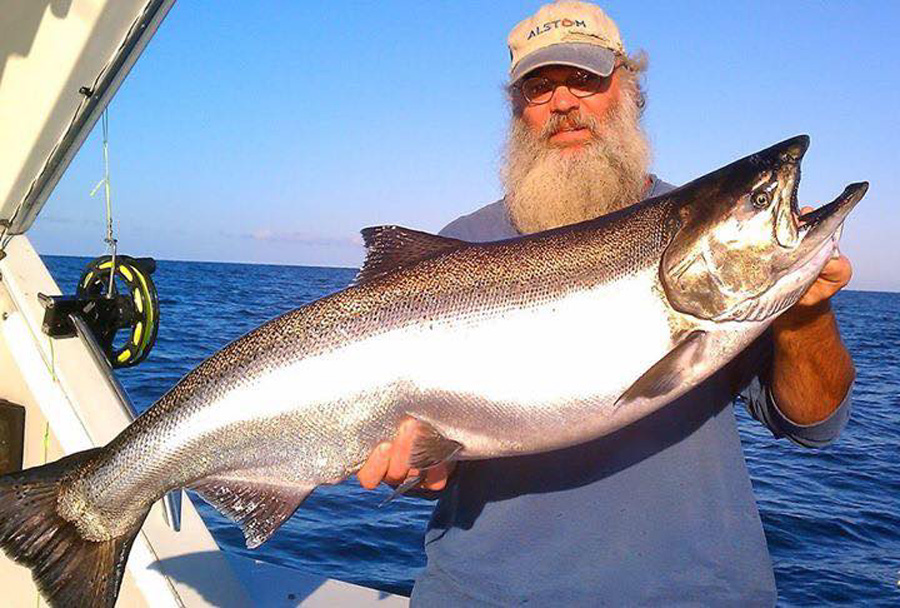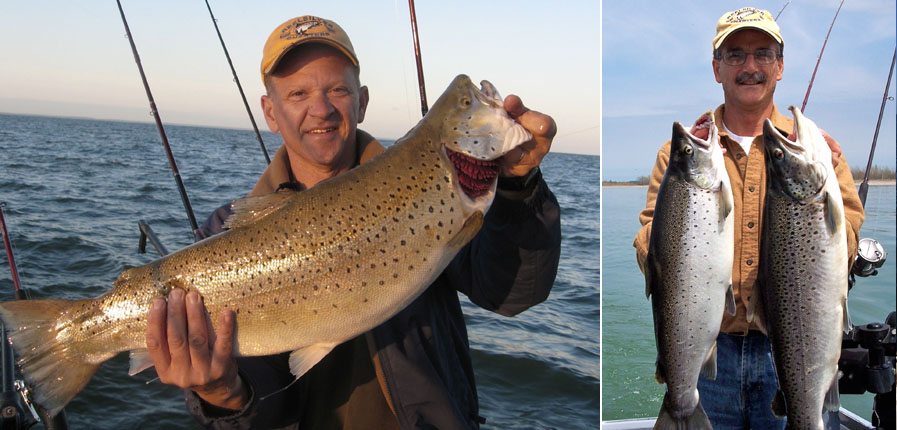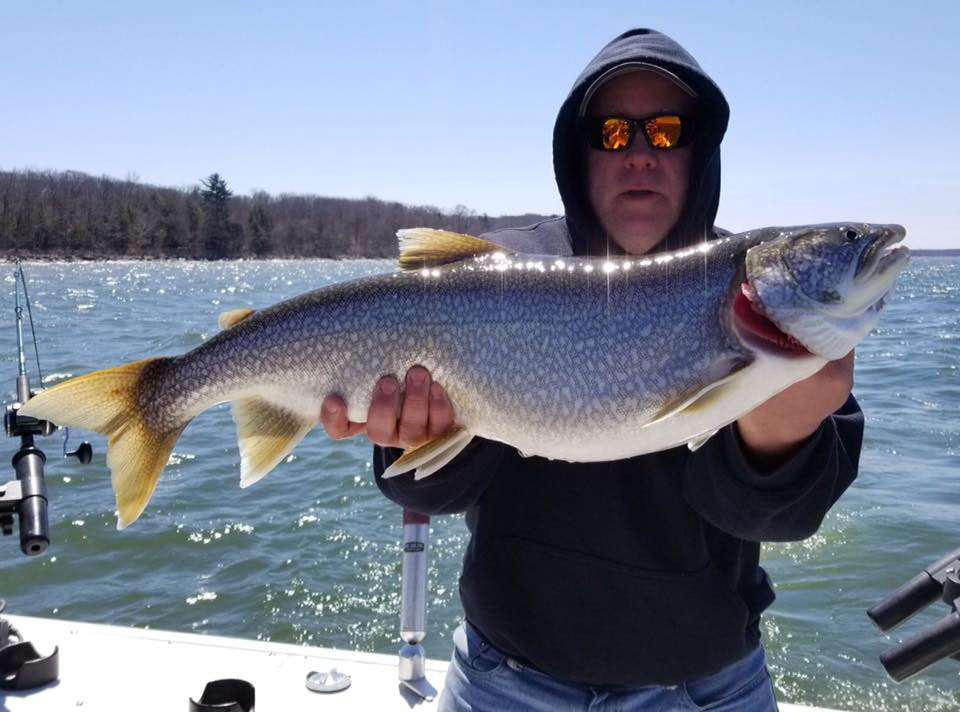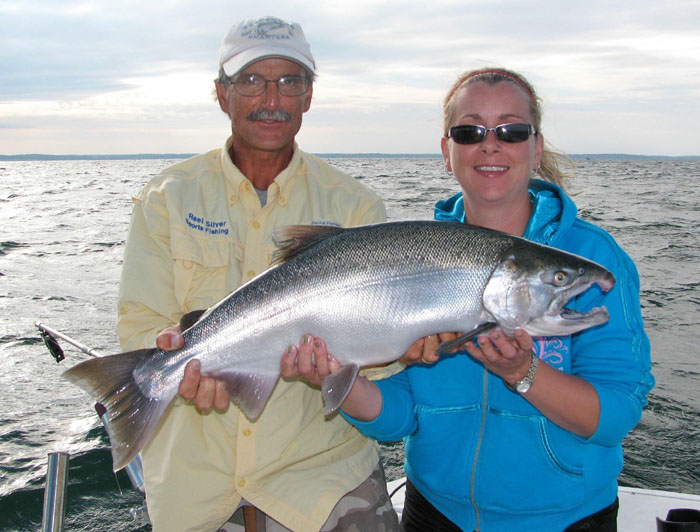Lake Ontario Fishing
Lake Ontario is teeming with huge fish.
This page explains the species of fish we seek.


King Salmon:
Chinook Salmon may spend one to eight years in the ocean (averaging from three to four years) before returning to their home rivers to spawn. The salmon also undergo radical morphological changes as they prepare for the spawning event ahead. All salmon lose the silvery blue they had as ocean fish, and their colour darkens, sometimes with a radical change in hue. Salmon are sexually dimorphic, and the male salmon develop canine-like teeth and their jaws develop a pronounced curve or hook, called a "kype". Studies have shown that larger and more dominant male salmon have a reproductive advantage as female Chinook are often more aggressive toward smaller males.

The Chinook is blue-green, red, or purple on the back and top of the head, with silvery sides and white ventral surfaces. It has black spots on its tail and the upper half of its body. Chinook have a Black gum line which is present in both salt and freshwater. Adult fish range in size from 24 to 36 in (61 to 91 cm), but may be up to 58 in (150 cm) in length; they average 10 to 50 lb (4.5 to 22.7 kg), but may reach 130 lb (59 kg).
Lake Run Brown Trout:
The Brown Trout is a European species of salmonid fish that has been widely introduced into suitable environments globally. It includes both purely freshwater populations, as well as anadromous forms. The latter migrates to the oceans for much of its life and returns to fresh water only to spawn

The brown trout is a medium-sized fish, growing to 20 kg (44 lb) or more and a length of about 100 cm (39 in) in some localities. Brown trout can live 20 years, but as with the Atlantic salmon, a high proportion of males die after spawning, and probably fewer than 20% of anadromous female kelts recover from spawning. The migratory forms grow to significantly larger sizes for their age due to abundant forage fish in the waters where they spend most of their lives.
Steelhead Trout
Steelhead trout is a name given to the anadromous form of the coastal rainbow trout or redband trout. The steelhead are native to freshwater and ocean environments across North America, but have been introduced to every other continent except Antarctica. Steelhead use aquatic obstructions like vegetation, boulders, and fallen trees as protection.

During spawning, the fish will lay their eggs on gravel bottoms of freshwater tributaries. The female digs out a hole called a redd. She then lays the eggs, and a male fertilizes them. The females will then cover the eggs with the gravel. The eggs will remain like this until they hatch. Unlike salmon, the steelhead can spawn then return to the ocean without any hardships. This allows the steelhead to spawn multiple times within its life.
Lake Trout
Lake trout is a freshwater char living mainly in lakes in northern North America. Lake trout are the largest of the chars; the record weighed almost 102 pounds (46 kg) (netted) with a length of 50 inches (130 cm), and 15–40-pound (6.8–18.1-kilogram) fish are not uncommon.

The average length is 24–36 inches (61–91 centimetres). The largest caught on a rod and reel according to the IGFA was 72 pounds (33 kg), caught in Great Bear Lake in 1995 with a length of 59 inches (150 cm).
Walleye Pike
The walleye (Sander vitreus, synonym Stizostedion vitreum), also called the yellow pike, is a freshwater perciform fish native to most of Canada and to the Northern United States. Walleyes show a fair amount of variation across watersheds. In general, fish within a watershed are quite similar and are genetically distinct from those of nearby watersheds.

Walleyes grow to about 80 cm (31 in) in length, and weigh up to about 9 kg (20 lb). The maximum recorded size for the fish is 107 cm (42 in) in length and 13 kilograms (29 lb) in weight. The rate depends partly on where in their range they occur, with southern populations often growing faster and larger. In general, females grow larger than males. Walleyes may live for decades; the maximum recorded age is 29 years.
Coho Salmon
During their ocean phase, coho salmon have silver sides and dark-blue backs. During their spawning phase, their jaws and teeth become hooked. After entering fresh water, they develop bright-red sides, bluish-green heads and backs, dark bellies and dark spots on their backs.

Sexually maturing fish develop a light-pink or rose shading along the belly, and the males may show a slight arching of the back. Mature adults have a pronounced red skin color with darker backs and average 28 inches (71 cm) and 7 to 11 pounds (3.2 to 5.0 kg), occasionally reaching up to 36 pounds (16 kg).
Stop Wishin' and get Fishin'!
© Reel Silver Charters


